The latest round of Winter 2024/2025 snowfall predictions confirms the atmospheric presence of the La Nina event. Compared to the forecast from last month, the new data shows a snowfall increase over parts of the United States and southern Canada and slightly more snowfall over Europe than in the previous forecast.
We will first look at the leading global weather driver for the upcoming weather seasons, the cold La Niña in the Pacific, and its expected background influence on the Winter 2024/2025 season.
As usual, we will look at the snowfall predictions month-by-month for the United States, Canada, and Europe, using the two leading global long-range forecasting systems. The latest forecast now also includes the data for March, so we can now also look into early Spring snowfall.
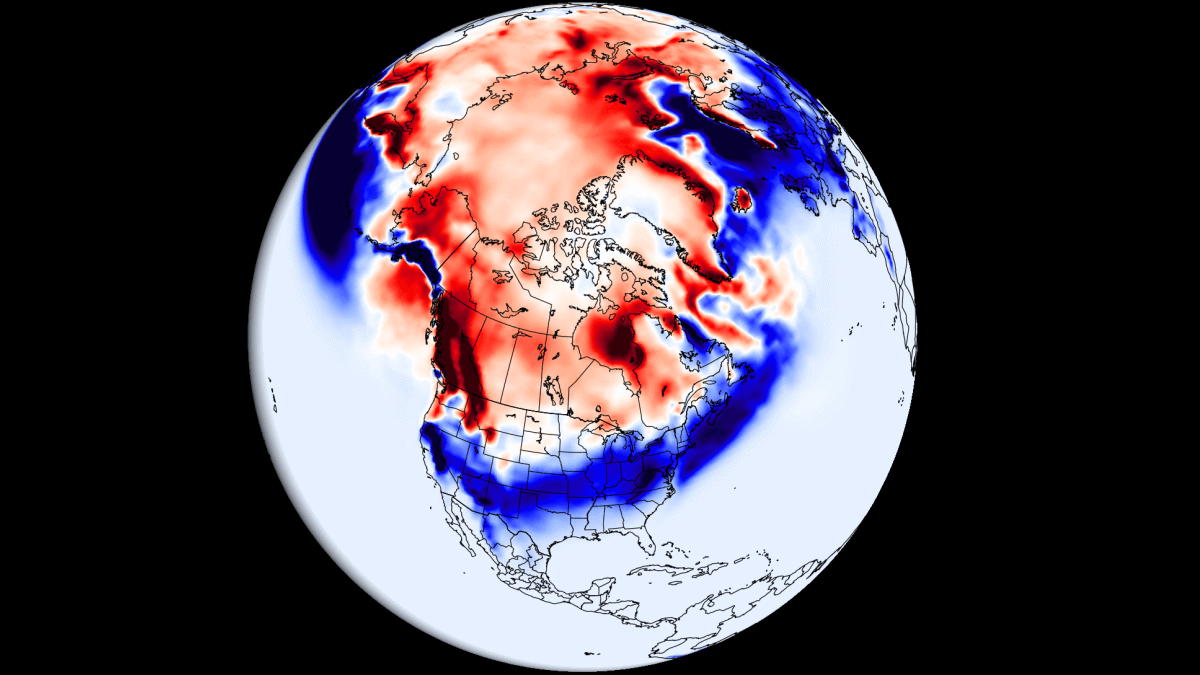
WEATHER IN THE LONG RANGE
The La Nina we mentioned above, is an ocean temperature anomaly in the ENSO regions. This is a region of the tropical Pacific Ocean that changes between warm and cold phases. Typically there is a phase change around every 1-3 years. The warm phase is called El Niño, and the cold phase is called La Niña.
ENSO phases significantly influence tropical rainfall, pressure patterns, and the complex dynamics between the ocean and the atmosphere. The image below shows the circulation pattern of a cold phase, which is forecast to influence the upcoming Winter season.
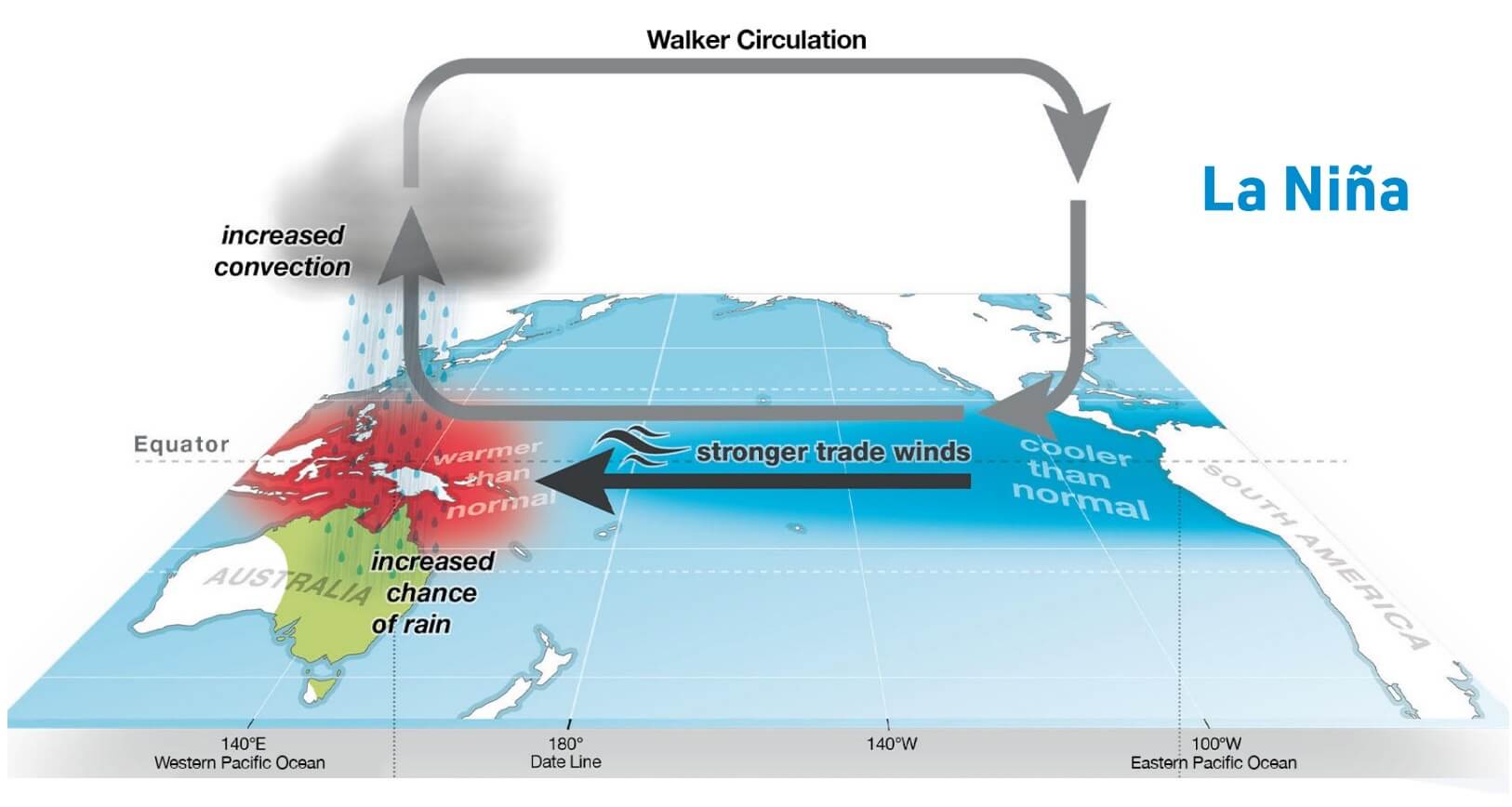
By changing the circulation, ENSO significantly impacts tropical rainfall and pressure patterns. This changes the atmosphere-ocean feedback system, which spreads the ENSO influence globally, impacting the Winter temperature and snowfall patterns.
You can see the ocean anomaly analysis below, with the marked main ENSO region. It shows colder-than-normal ocean surface in the central and eastern ENSO regions. These cold anomalies have a “wave-like” shape because of the strong easterly trade winds that push the waters towards the west, bringing deeper, colder water to the surface.

Below is an analysis/forecast image from NMME, which shows the ENSO ocean temperature drop as the warm phase ended in spring. Negative anomalies and cooling are forecast over the Autumn and Winter of 2024/2025. The forecast average is within the La Niña threshold but shows a weak to moderate event.
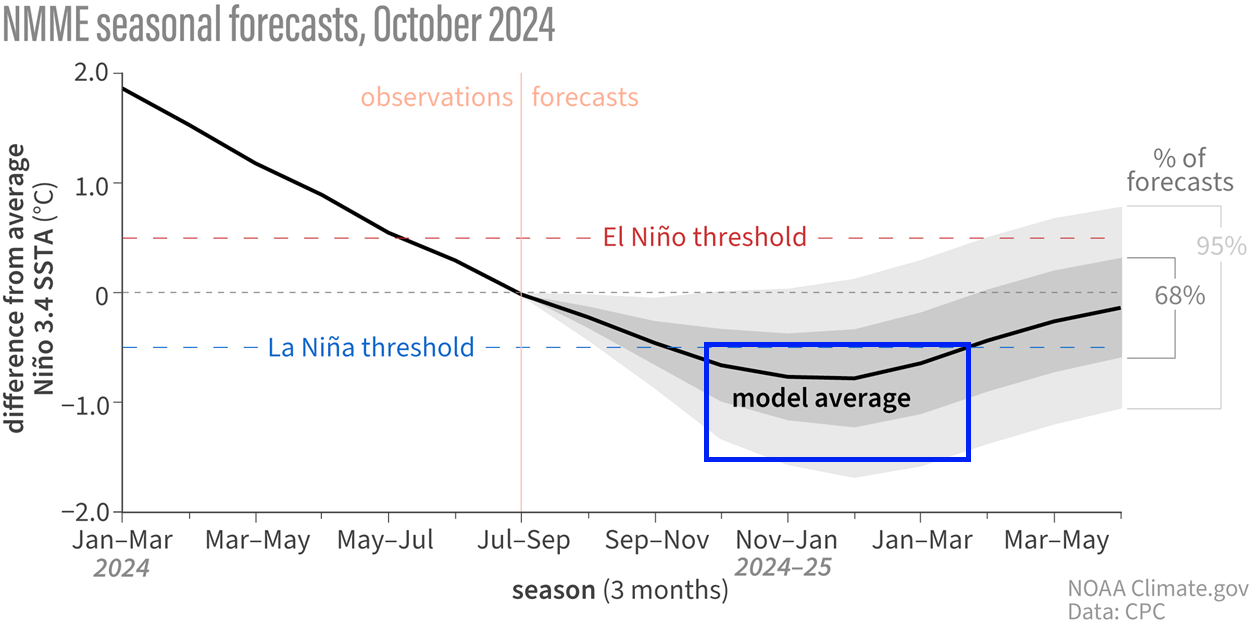
The image above shows that even in early spring, the ocean anomaly was still above normal but began cooling rapidly. Below is also a high-resolution video animation that shows how the ocean went from warm to cold anomalies across the ENSO regions in the tropical Pacific.
Changes in the oceans are well known to impact winter weather patterns and also the snowfall potential. We will take a closer look at the weather influence that La Niña usually shows over North America, where it has a more direct impact.
Europe is not known to have any specific/direct influences, as it is too far from the source. But that does not mean it has no impact.
La Niña does change the weather globally, but apart from the direct influence over the United States and Canada, places like Europe have many other factors at work before any more direct La Niña influence can spread this far.
LA NINA PATTERN OVER NORTH AMERICA
The main influence of these ocean anomalies can be seen in the changing jet stream patterns. A jet stream is a large and powerful stream of air (wind) at around 8-11km (5-7 mi) altitude, flowing like an atmospheric river.
Typically, a strong blocking high-pressure system in the North Pacific is the most common effect of a cold ENSO phase (La Niña). That usually redirects the polar jet stream down over the northern United States.
The circulation of the strong high-pressure system promotes the development of a low-pressure region over Alaska and western Canada. That pushes the jet stream downwards between the two strong pressure systems into the Northern United States.
The image below shows jet stream redirection from La Niña and the resulting weather patterns developing over the United States and Canada.
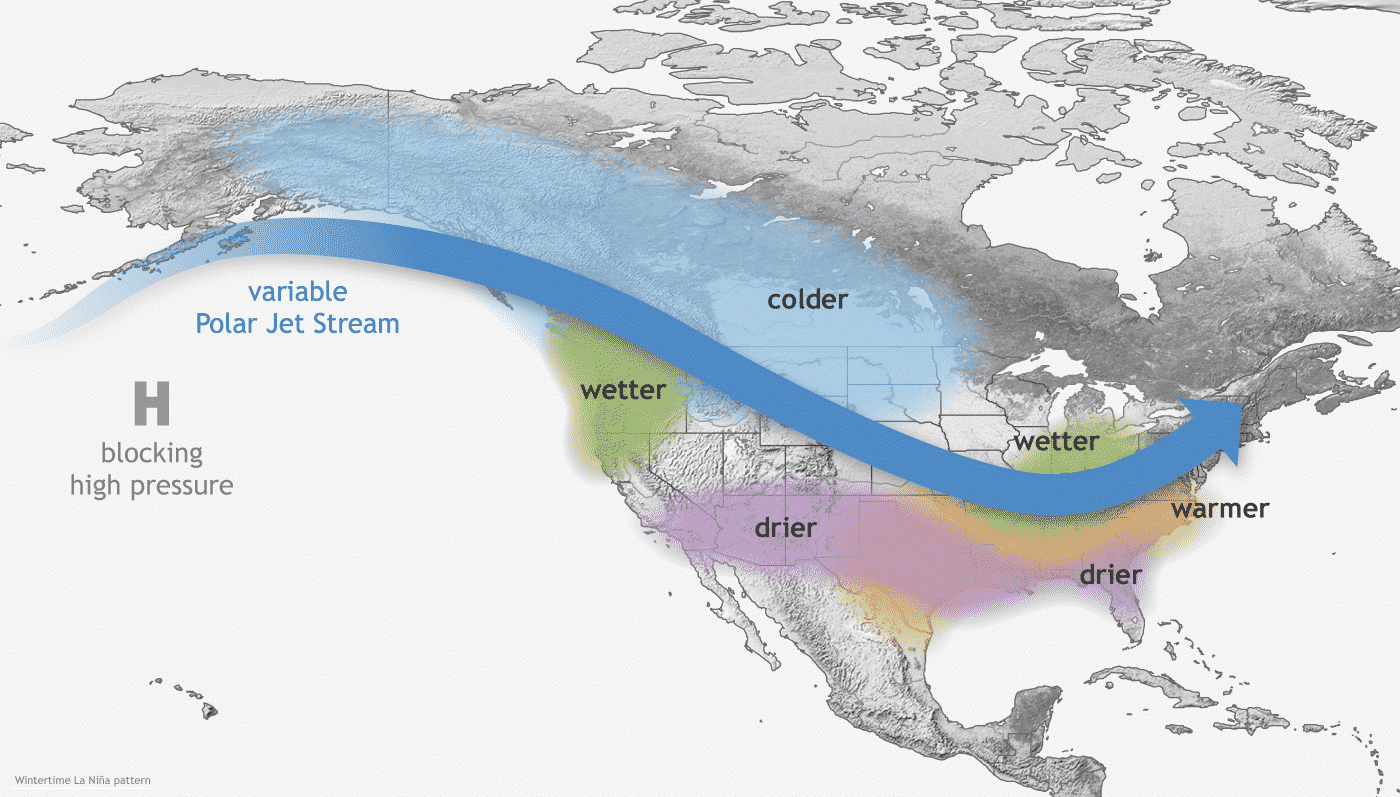
The displaced jet stream brings colder temperatures and winter storms from the polar regions down into the northern and northwestern United States. Warmer and drier winter weather prevails over the southern states.
Looking at the temperature analysis for some of the more recent La Niña winters, you can see the cold anomaly area under the jet stream in western Canada and the northwestern United States. A cooler area extends over the Midwest and down into the south-central plains.
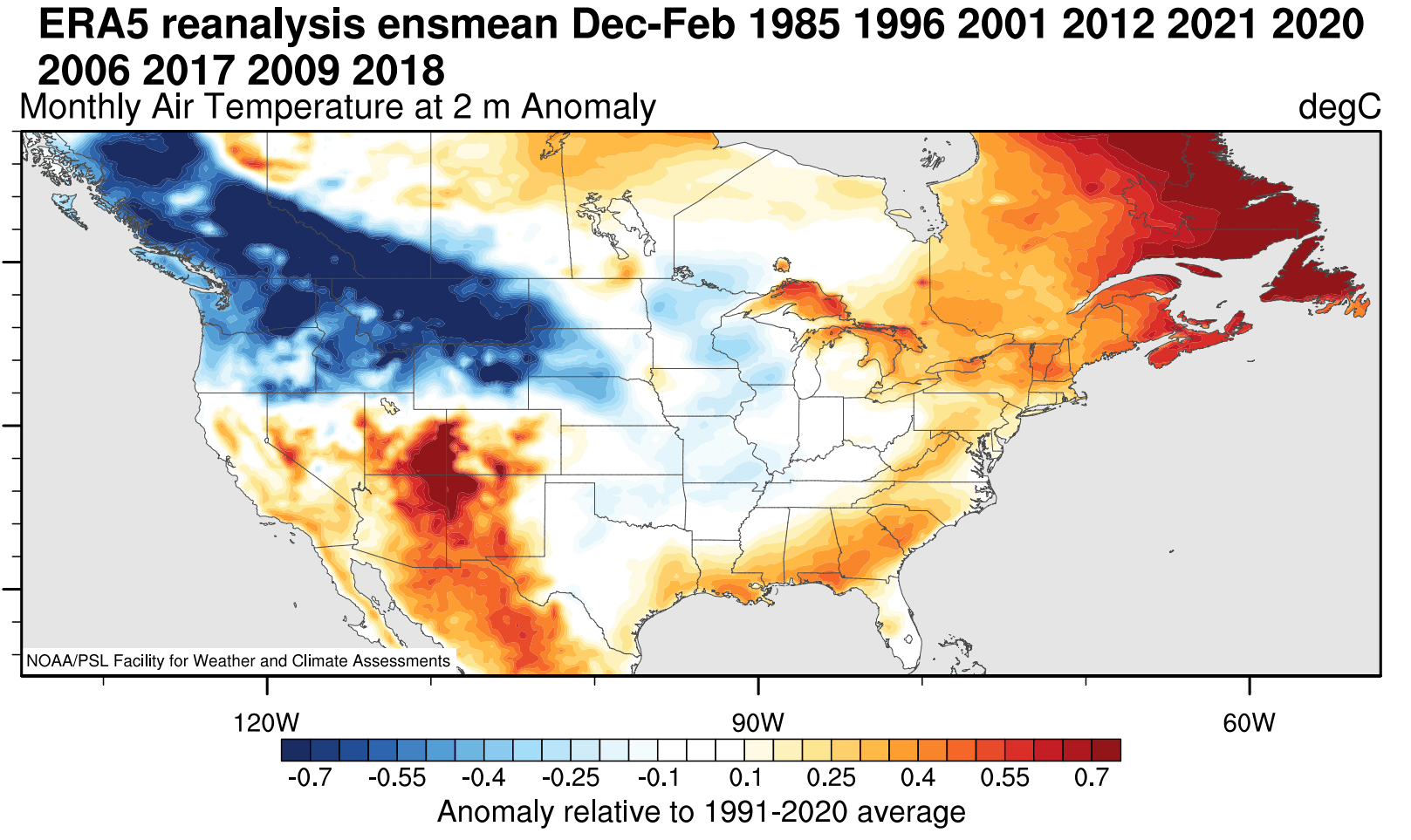
Warmer-than-normal weather and mild winter conditions develop in the southwestern and eastern United States and eastern Canada. The main winter weather dynamics usually develop between the warm and cold anomalies in the Midwest and the central United States.
Data also shows that the La Niña jet stream pattern significantly affects the snowfall potential over North America as the pressure systems take a different path.
The colder air is more easily accessible to the northern United States, which increases the snowfall potential if moisture is available. In the graphic below by NOAA-Climate, you can see the average snowfall pattern for weak La Niña years, like the forecast indicates for the upcoming Winter season.
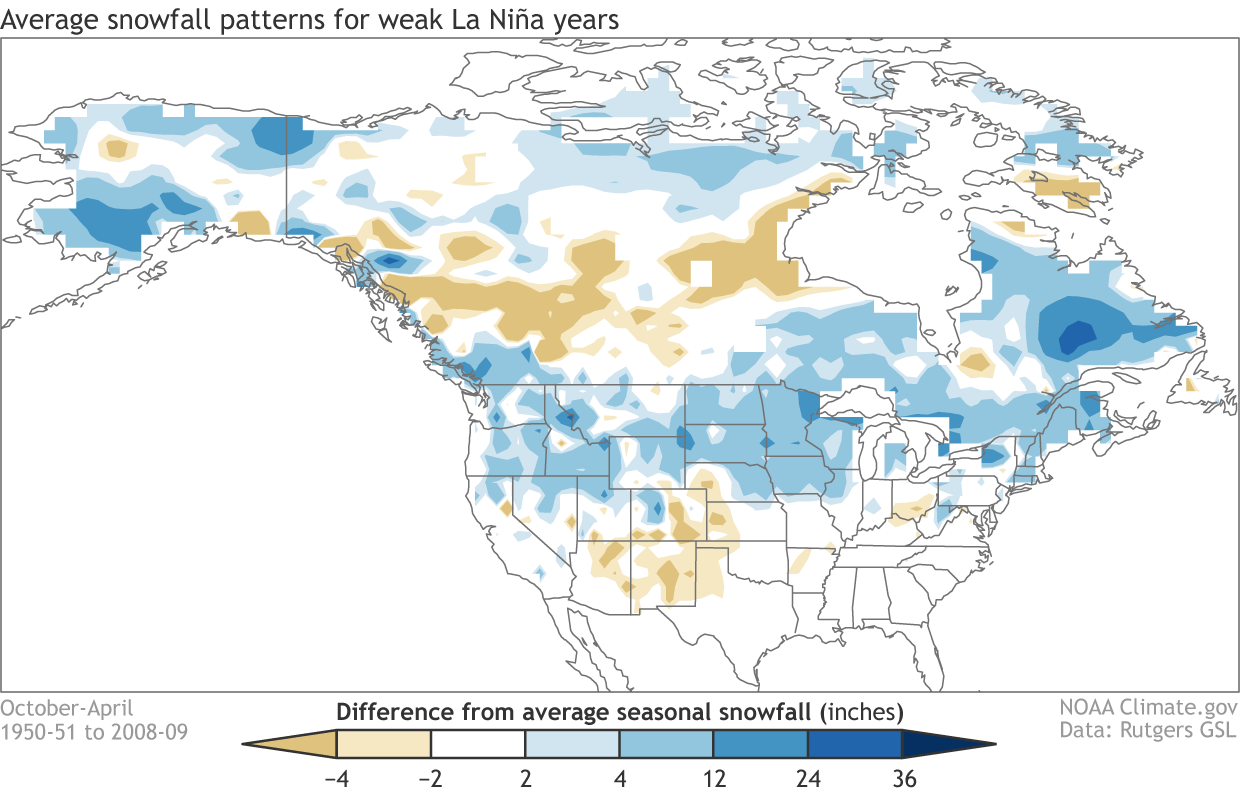
In addition to the northwestern United States and the Midwest, the northeastern United States and eastern Canada show more snowfall potential in such ENSO conditions.
Now, we are going to look at some actual Winter snowfall predictions from the latest forecast models issued in mid-late October. This latest round of data now also includes the month of March, so we will have a look at early Spring snowfall.
LATEST WINTER SNOWFALL PREDICTIONS
The format of this snowfall forecast is simple. We look at two well-established seasonal weather forecasting systems, the ECMWF and the UKMO. The data used to produce these images is the latest available, from mid and late October.
You will first see the seasonal average snowfall forecast for December-January-February, and then we will do a monthly breakdown. There are a lot of details in the monthly forecast that the whole seasonal average cannot show.
These forecasts show the snowfall anomaly. This means it shows the areas forecast to receive more (or less) snowfall than normal. For example, if an area is forecast to receive less snowfall than normal, it doesn’t mean it will receive no snow. It just means less snowfall than usual is expected.
ECMWF 2024/2025 SNOWFALL FORECAST
We will start with the ECMWF, the most often used and highly regarded seasonal forecasting system. We will first look at the Europe forecast, followed by the United States and Canada.
First, the seasonal average shows below-average snowfall over most of the continent. Some areas of increased snowfall are forecast over Scandinavia due to the influence of a low-pressure system and the jet stream over northern Europe.

But if we look at the seasonal forecast change, we can see that the latest forecast actually shows more snowfall than the previous forecast. Compared to the forecast data from September, the October data shows more snowfall over central and western Europe.

The latest December snowfall forecast shows less snowfall than normal over much of the continent. More snowfall is expected far north over northern Scandinavia.
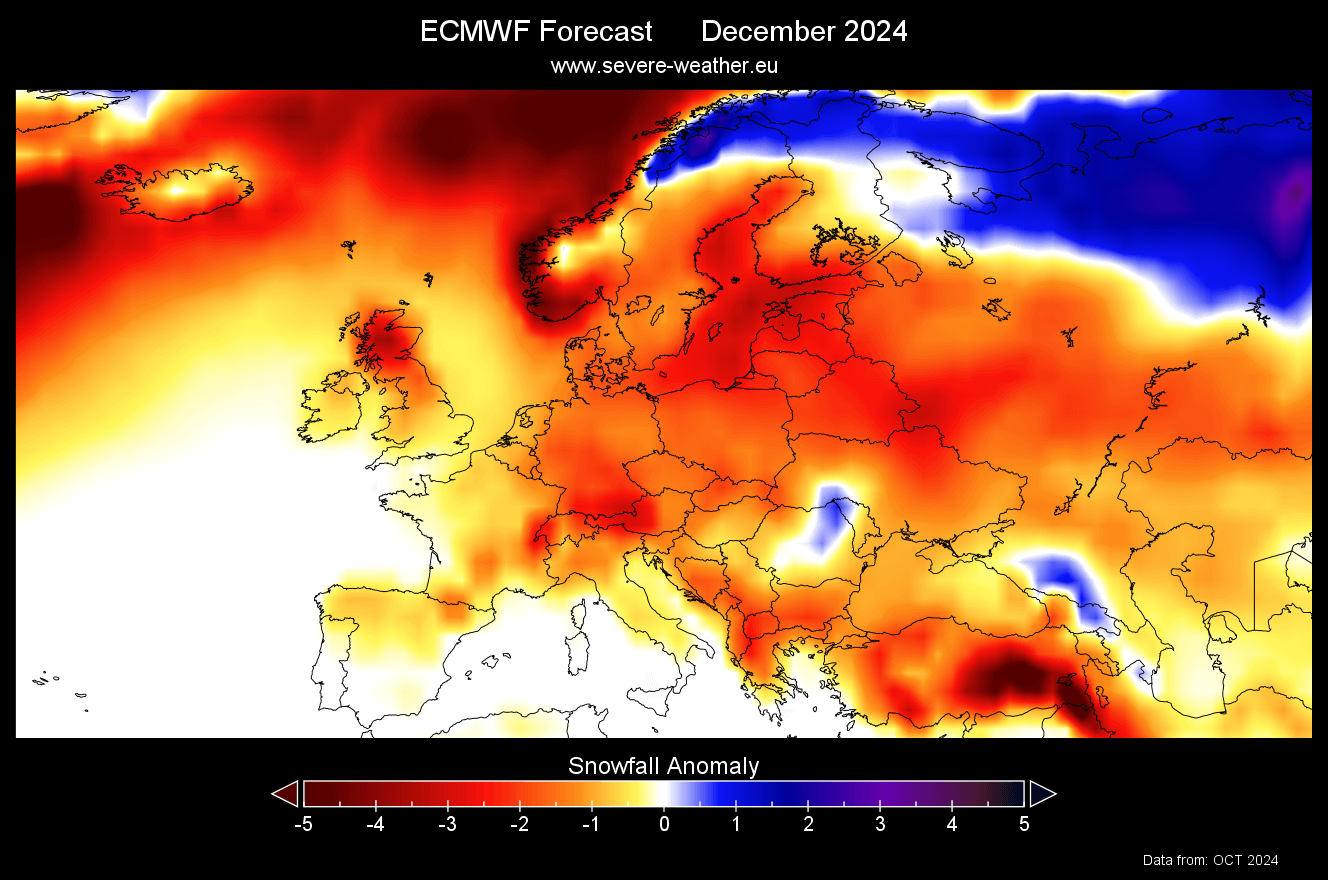
The January forecast continues the reduced snowfall potential over much of the continent. Overall the forecast is very similar to the previous month, with perhaps even less snowfall over the central and northwestern parts.
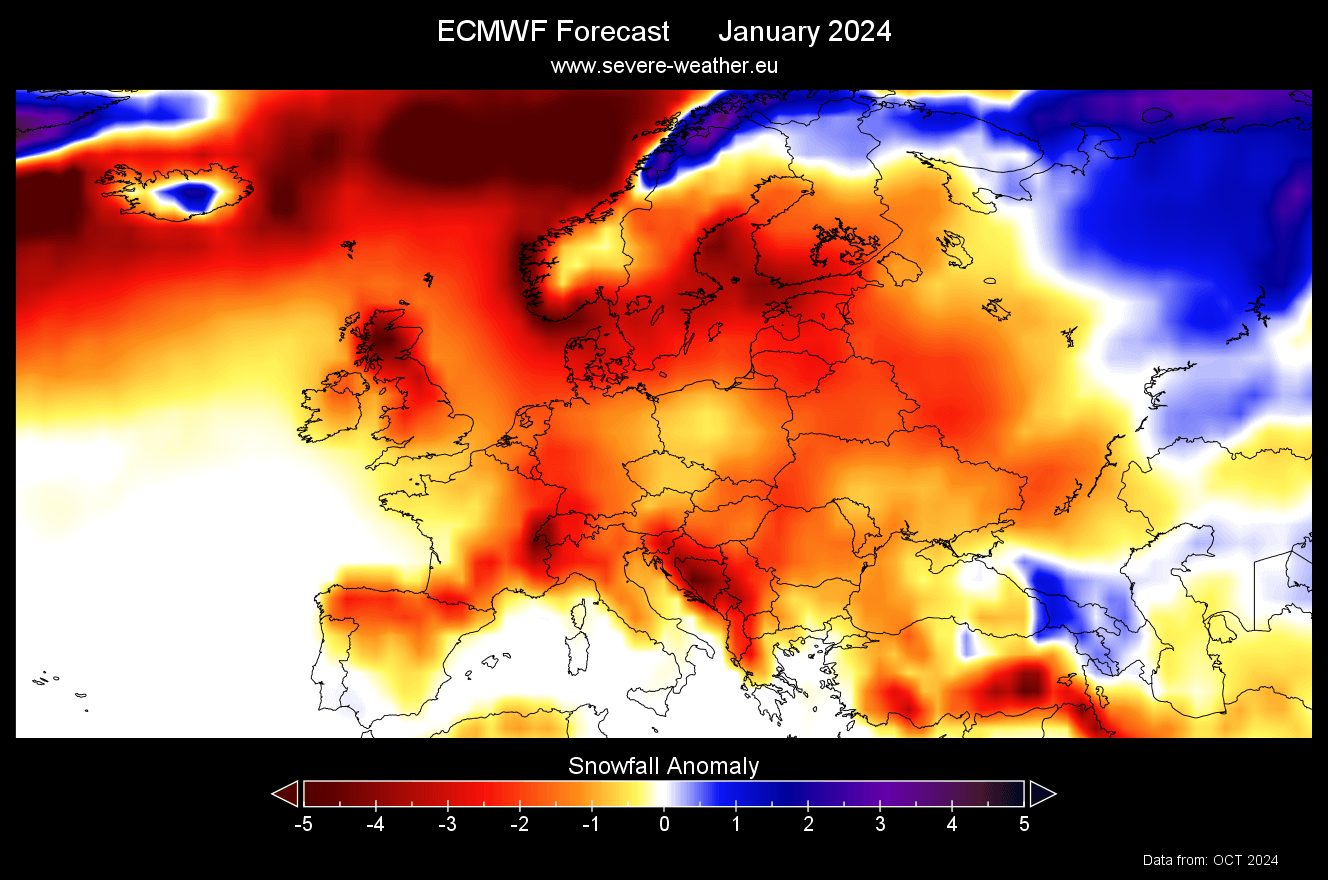
February shows some improvement, with most of the continent still under much less snowfall than normal. But some areas over central parts show a snowfall increase, and the overall deficit is lower than in previous months.
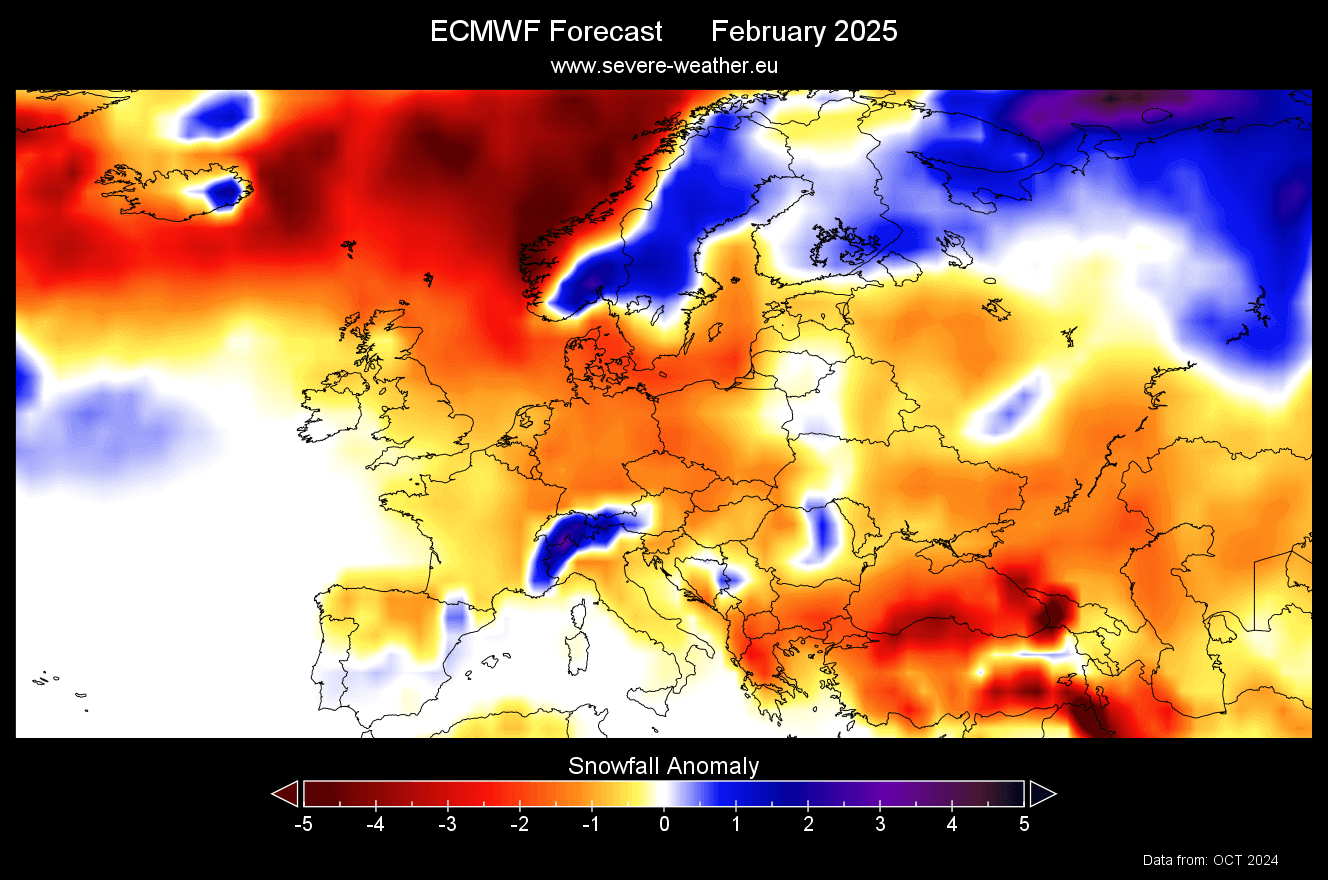
Below is the March snowfall forecast, showing a reduced snowfall potential over much of the continent. There are some central and southern parts (besides the far north) that show some early Spring snowfall.

NORTH AMERICA SEASONAL SNOWFALL FORECAST
The seasonal average for North America shows that most of the central and southern half of the United States is forecast with below-average snowfall. But compared to the forecast from last month, there is more snowfall in the forecast for parts of the northern United States and a lesser snow deficit overt the southwest and parts of the eastern United States.
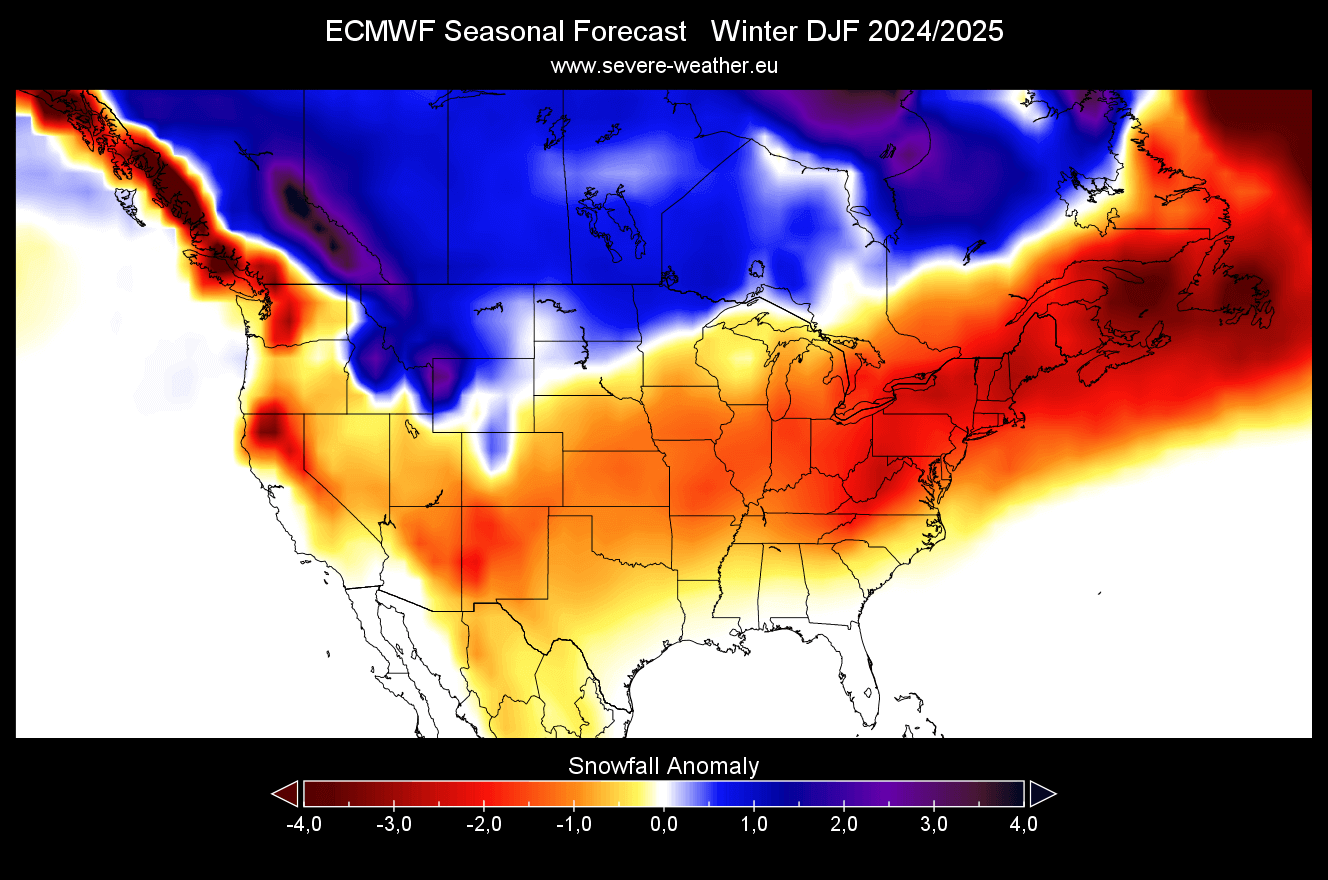
Canada shows much above-average snowfall over a large part of the country, except for the far southeastern area and the far west.
Looking at the seasonal forecast change from last month, we can see that the latest forecast shows more snowfall over much of the United States, apart from the Pacific Northwest and the northeastern United States.
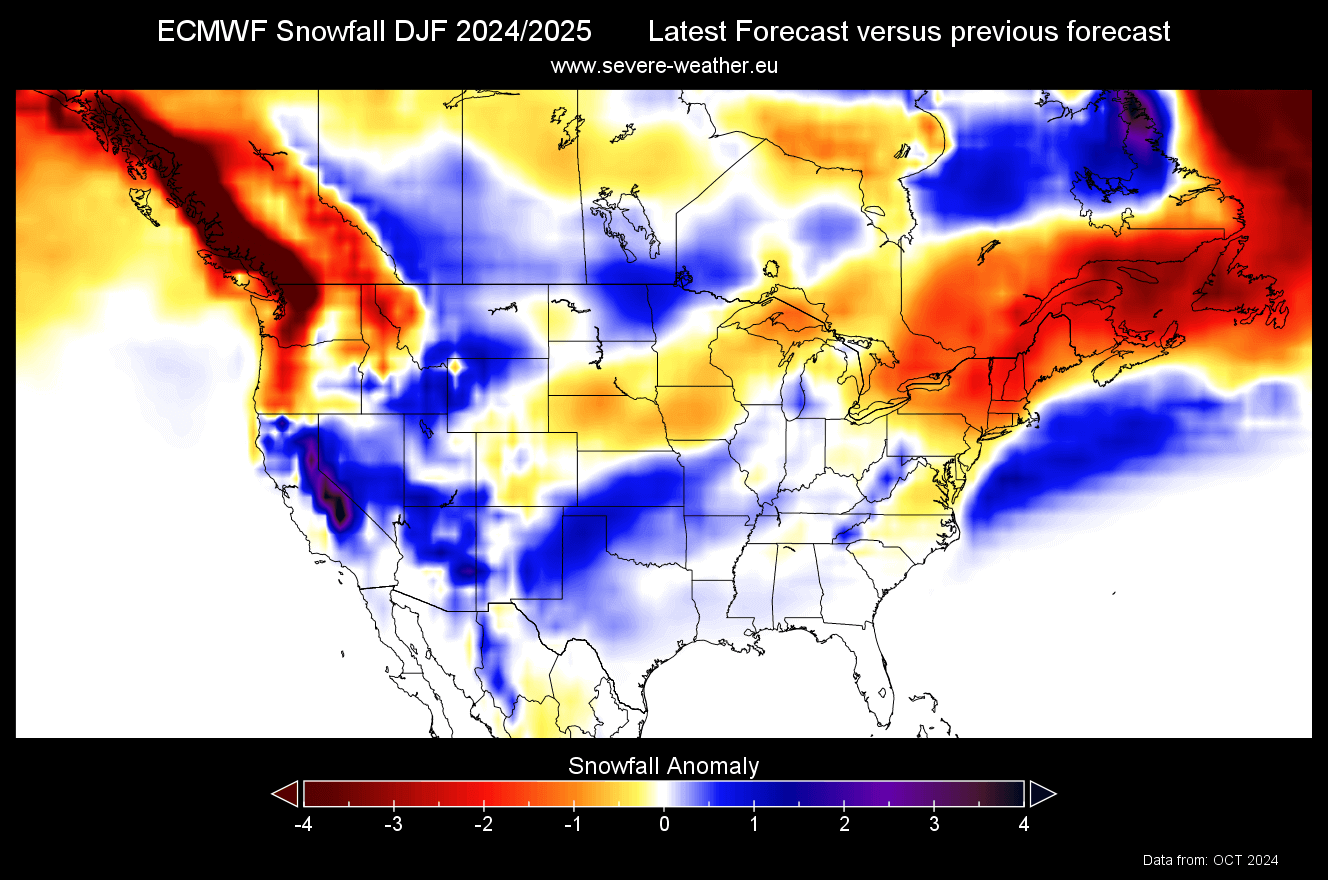
The December snowfall forecast shows less snowfall over almost the entire United States and more snowfall only over parts of the north-central United States. Canada shows the usual above-normal snowfall, pretty much over the whole southern half of the country.
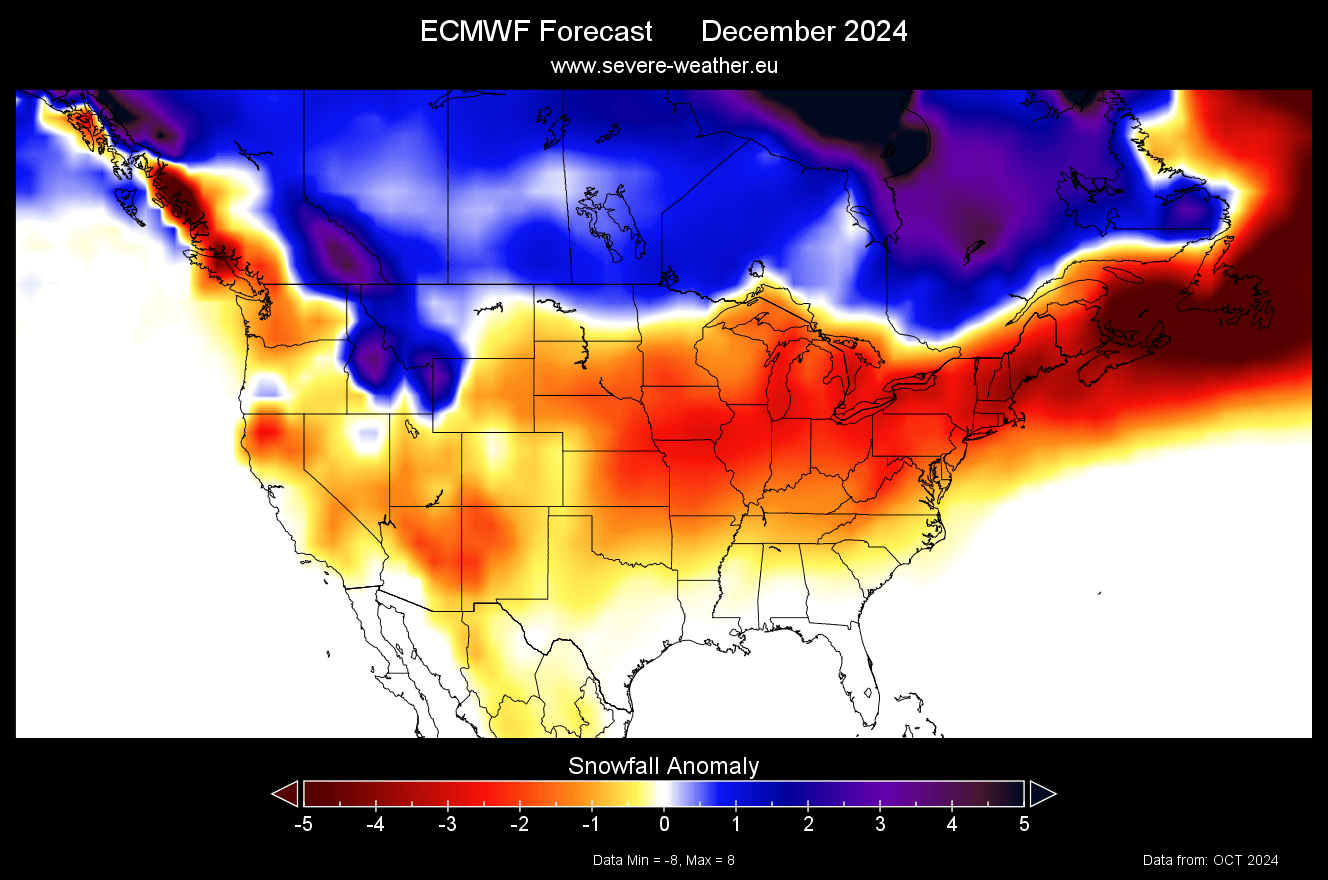
January snowfall forecast shows an expansion of the snowfall area. A strong area of above-normal snowfall is forecast over the northern United States and expanding into the upper Midwest. More snowfall is also seen over Canada, with the snowfall reducing over its southeastern parts.
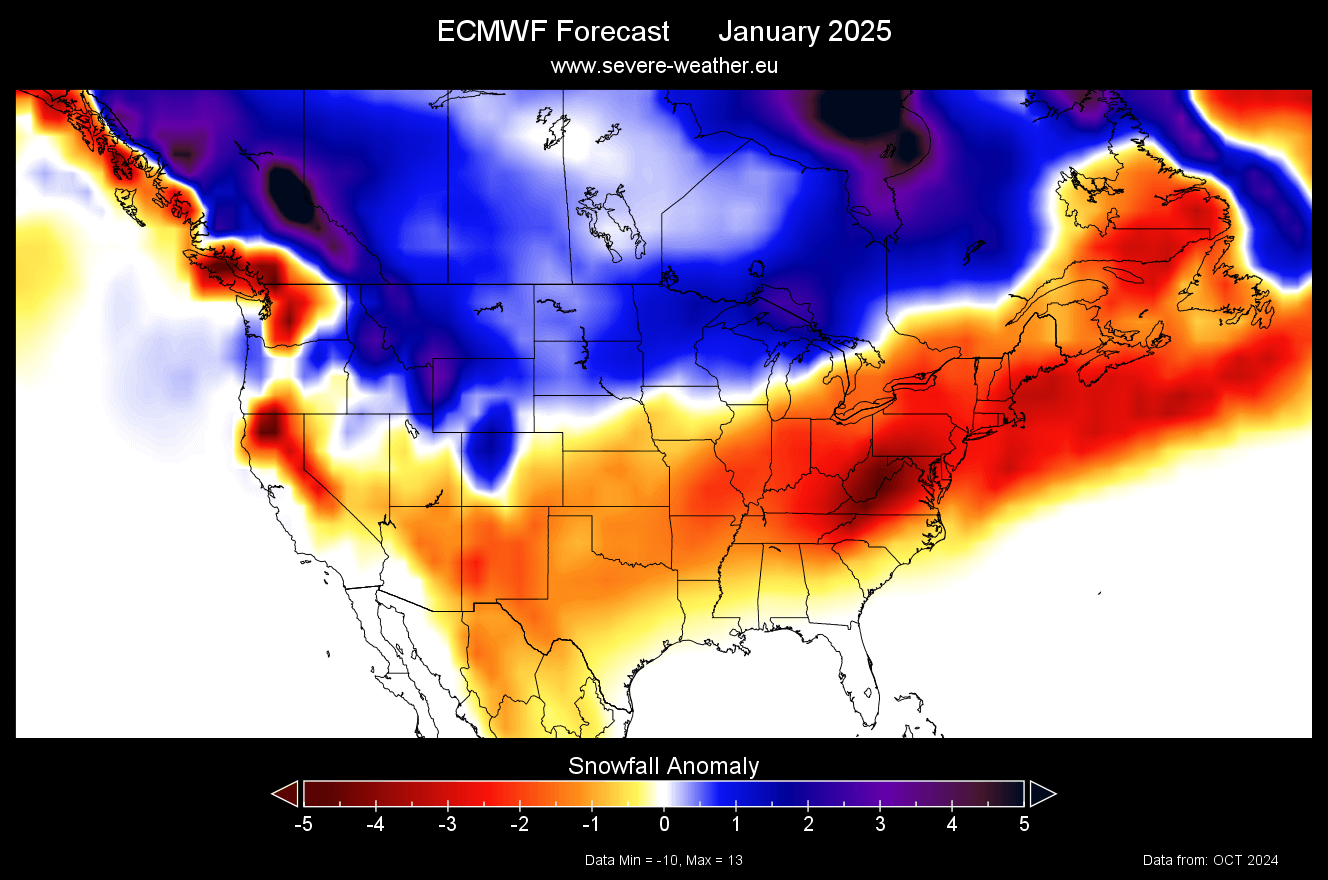
This January snowfall forecast from ECMWF still shows less snowfall across the eastern, and southern United States. Overall, the January forecast looks similar to a more typical La Niña pattern, except for the Northeastern United States, which should usually get more snowfall in such a pattern.
The February snowfall forecast shows more snowfall over the northwestern United States and western Canada. But interestingly, you can now see the northeastern United States getting more snowfall, along with the far southeastern Canada.
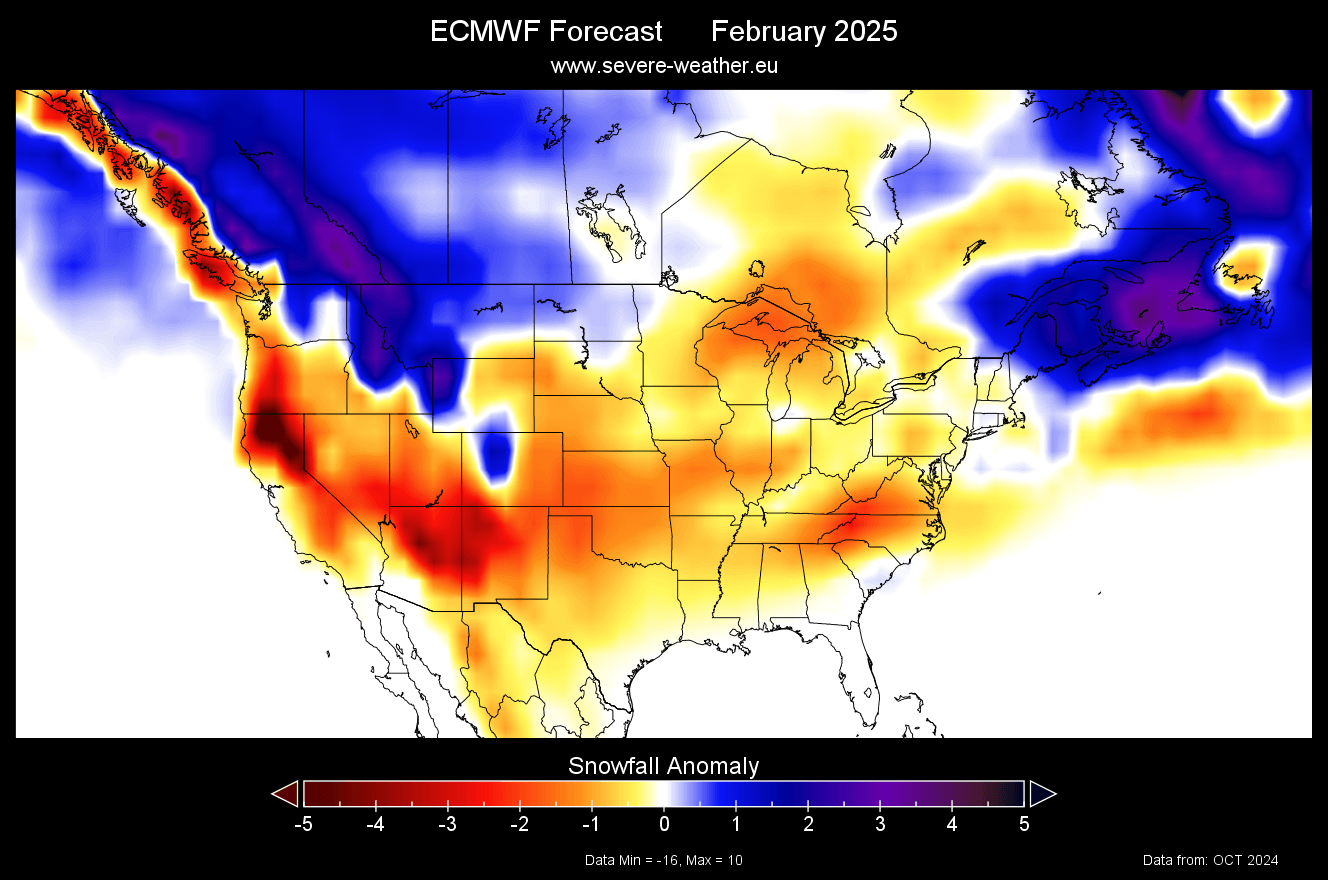
While the forecast for the rest of the United States still indicates less snowfall than normal, the overall deficit is not as bad as in the previous forecast cycle from September.
The first March snowfall forecast shows continued increased snowfall across the far northern United States and southwestern Canada. But the rest of the U.S. and also southeastern Canada is forecast to have a weaker early Spring snowfall season.

UKMO WINTER 2024/2025 SNOWFALL UPDATE
We use the UKMO long-range forecasting system along the ECMWF to estimate how “dependable” each forecast is. If both forecasts show a very similar image, it gives a higher confidence in the overall accuracy.
The seasonal average for Europe shows another very weak snowfall forecast identical to the ECMWF. Most of the continent is forecast to have less snowfall than normal, except for some northern parts under the jet stream.
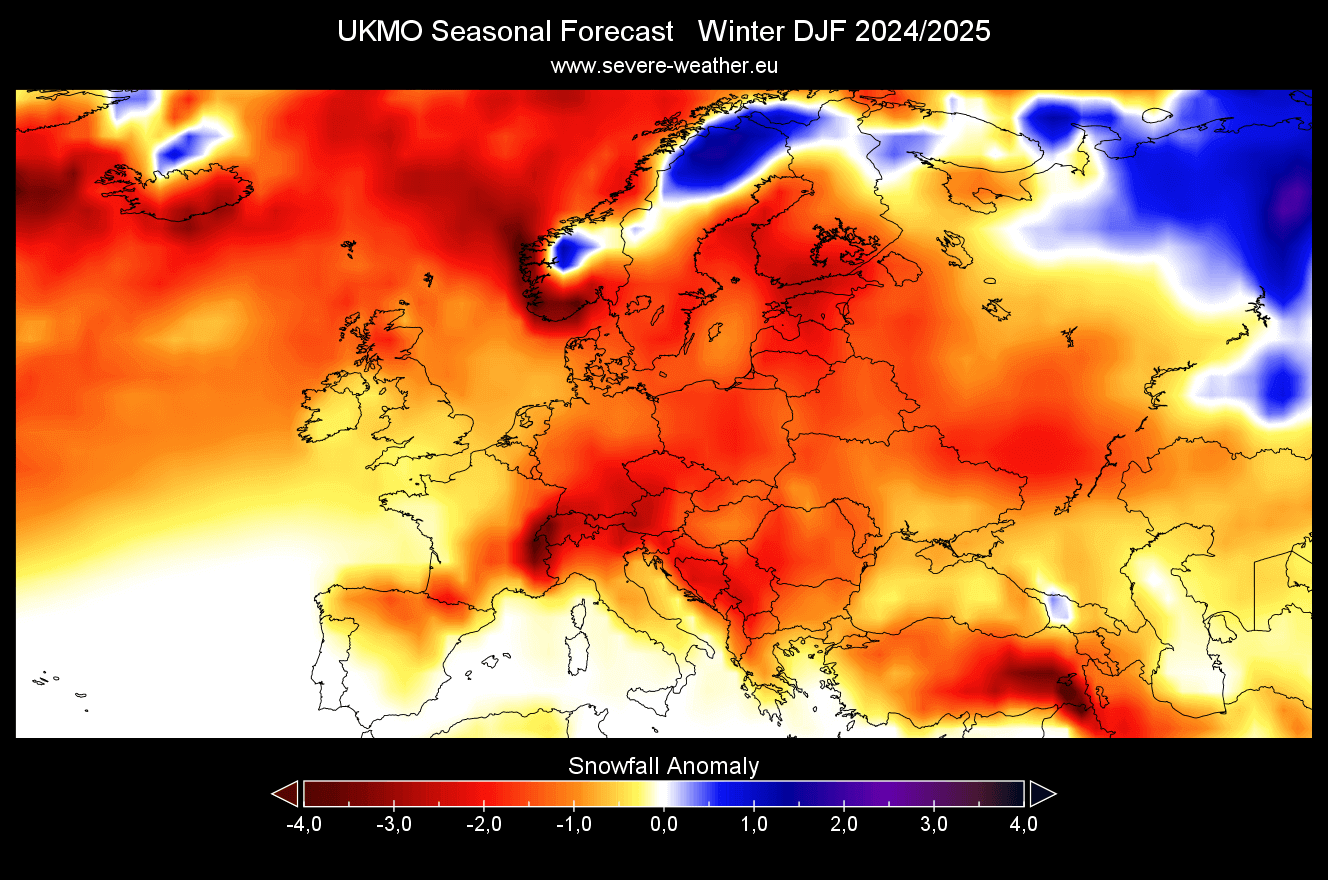
But compared to the previous forecast data, we can see that the latest forecast actually shows more snowfall over much of the mainland.
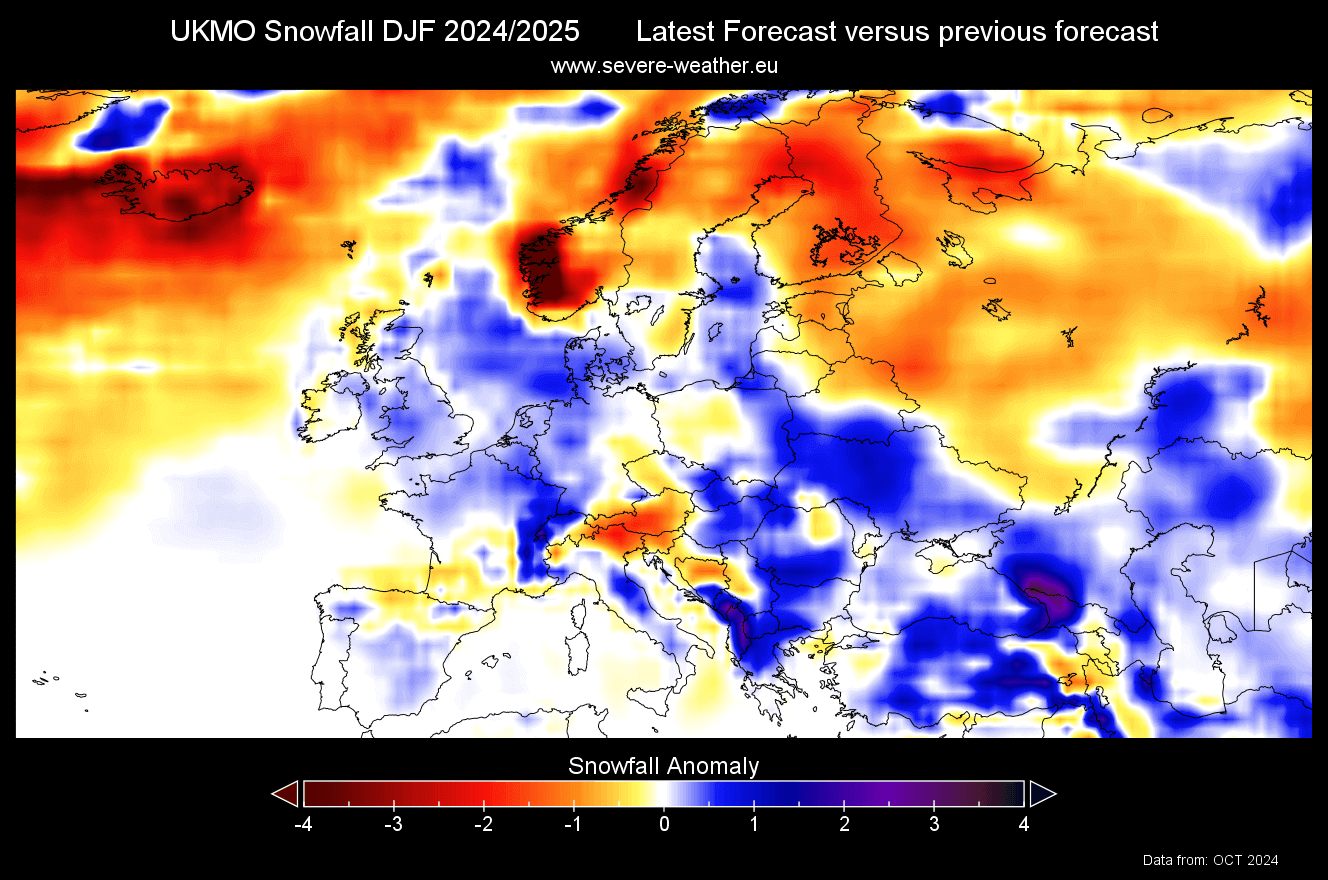
The December snowfall forecast shows quite a snowfall deficit over the whole continent. This shows a slow start to the snow season 2024/2025.
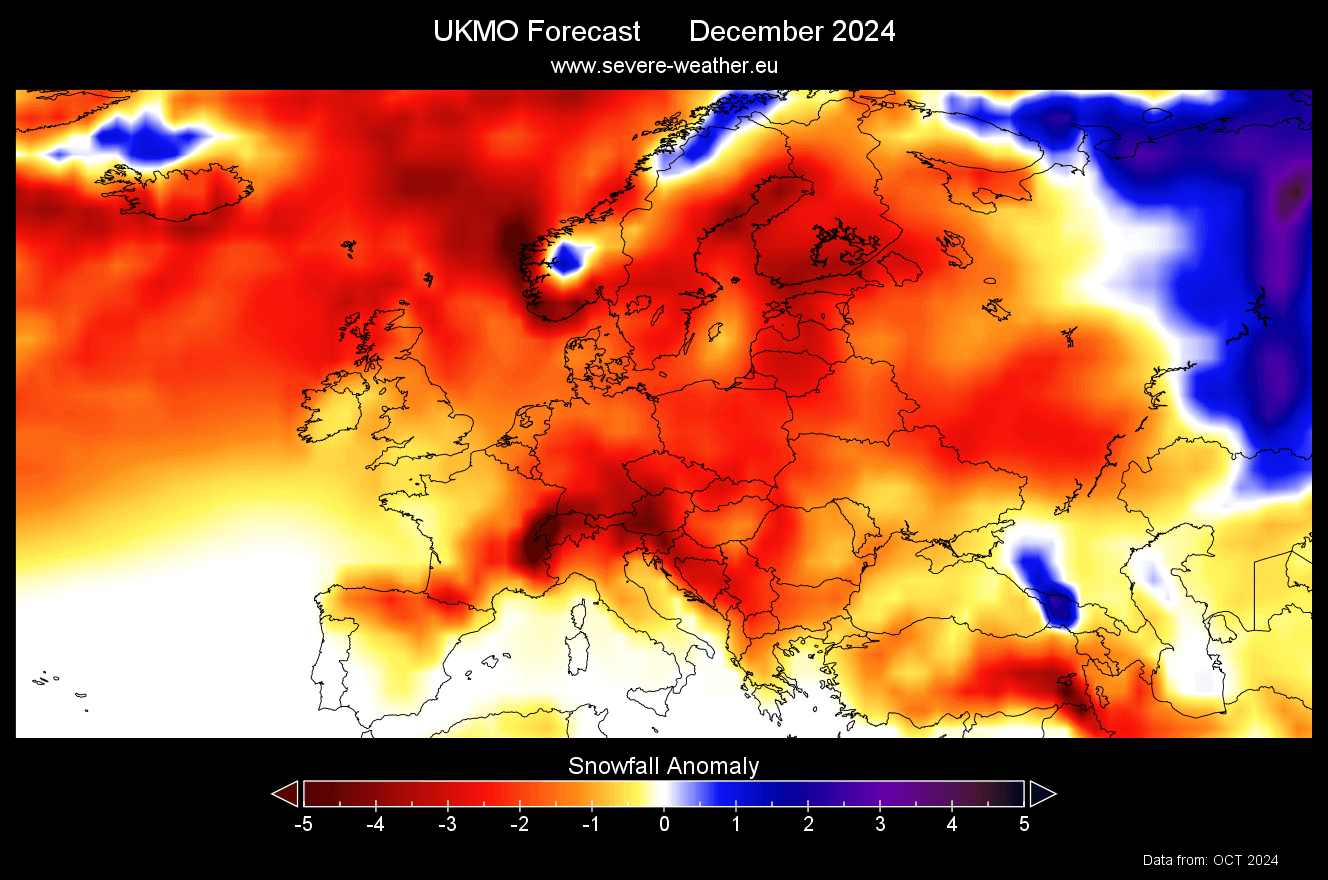
While no apparent change is seen for January, the forecast does show less of a snowfall deficit compared to December. So while the red colors show less snowfall than normal, it does matter if the forecast shows -1 or -5, as a lower deficit still just means less snow than normal, not no snow at all.
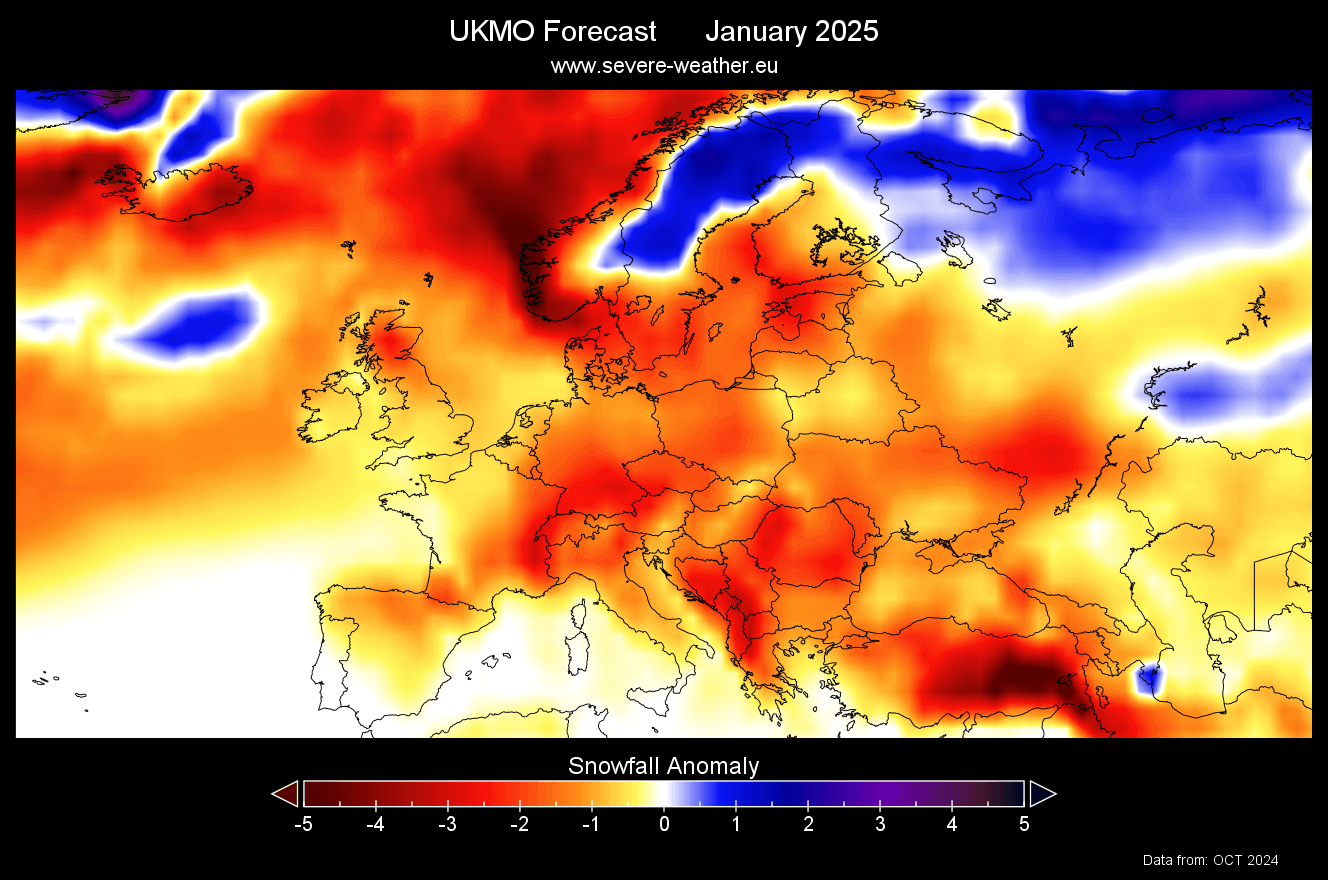
February shows some improvement, with some areas having near-normal snowfall or even above normal, like in the western Alps. This shows that while the snow season will start to slow, it is forecast to improve in the second half of winter.

The first March forecast shows a weak snowfall trend in early Spring, except for the northern parts.
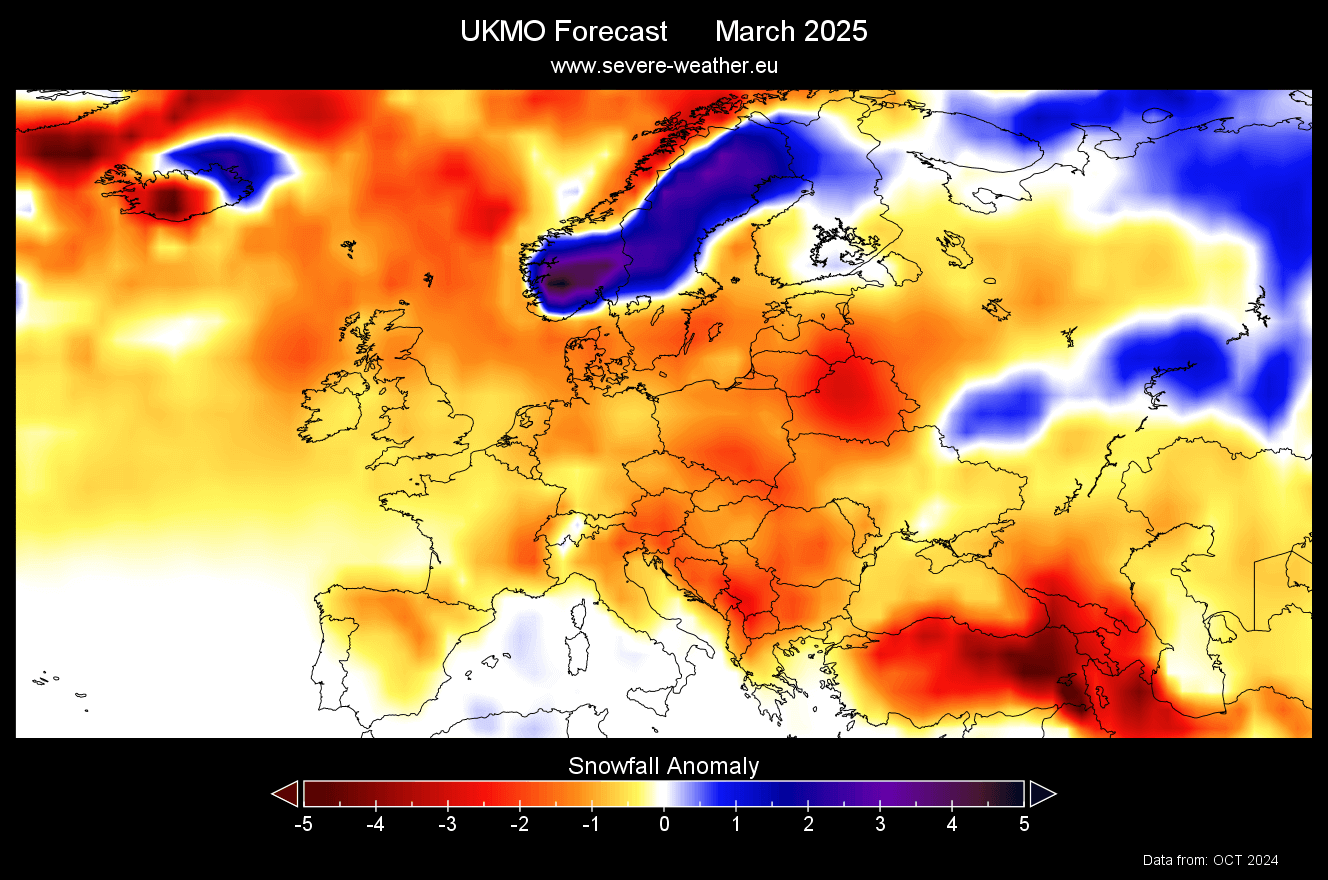
NORTH AMERICA UKMO SNOWFALL FORECAST
The average seasonal forecast for North America shows more snowfall potential across the far northern United States and southern Canada. Less snowfall is forecast over much of the southern and eastern United States and far southeastern Canada, just like in the previous model.
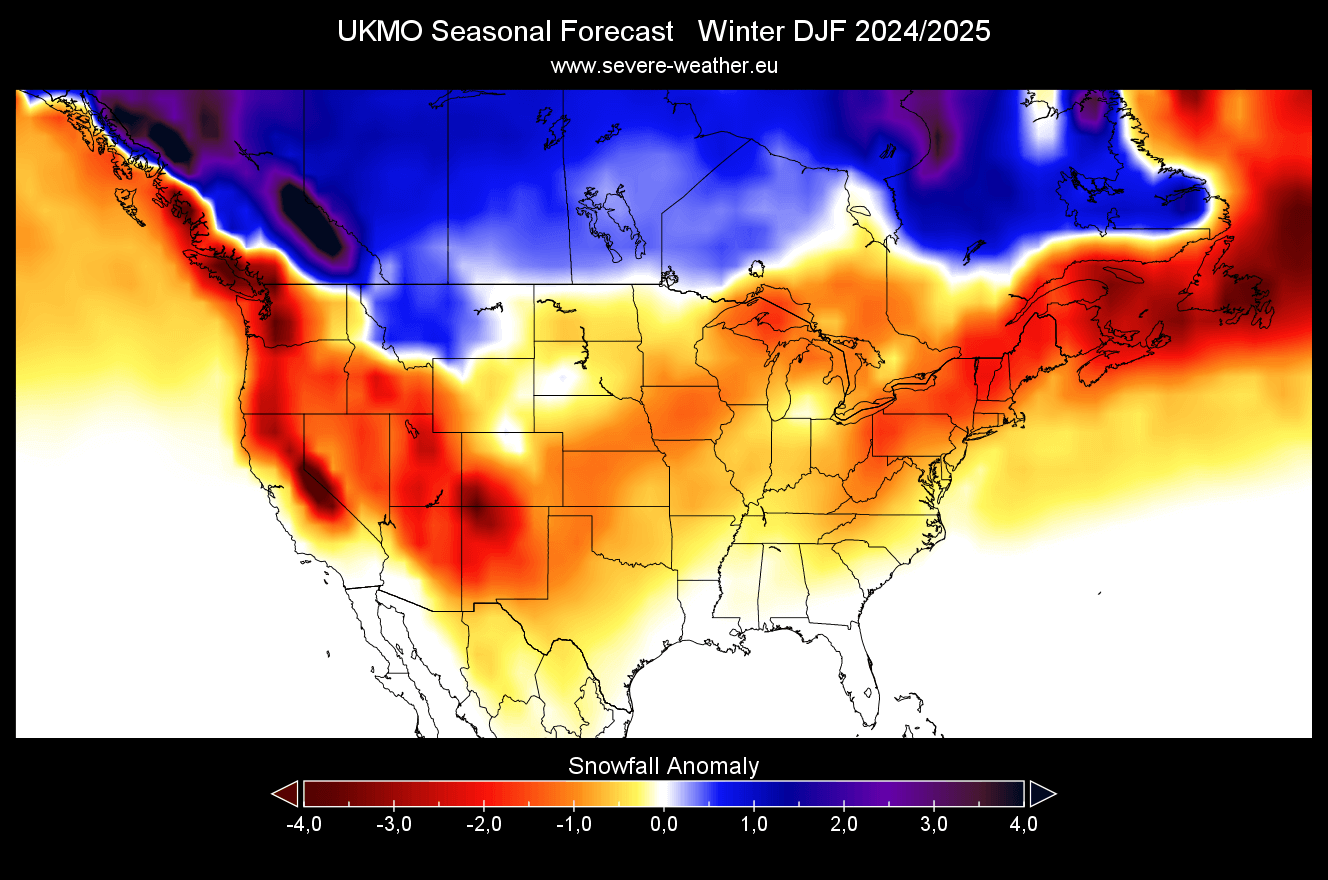
But you can see some areas having near-normal snowfall over the northern United States and over parts of the Midwest.
Compared to the forecast data issued in September, we can see that the latest forecast actually shows more snowfall over much of the central and eastern United States. This is not the total snowfall increase but just compared to the previous run.
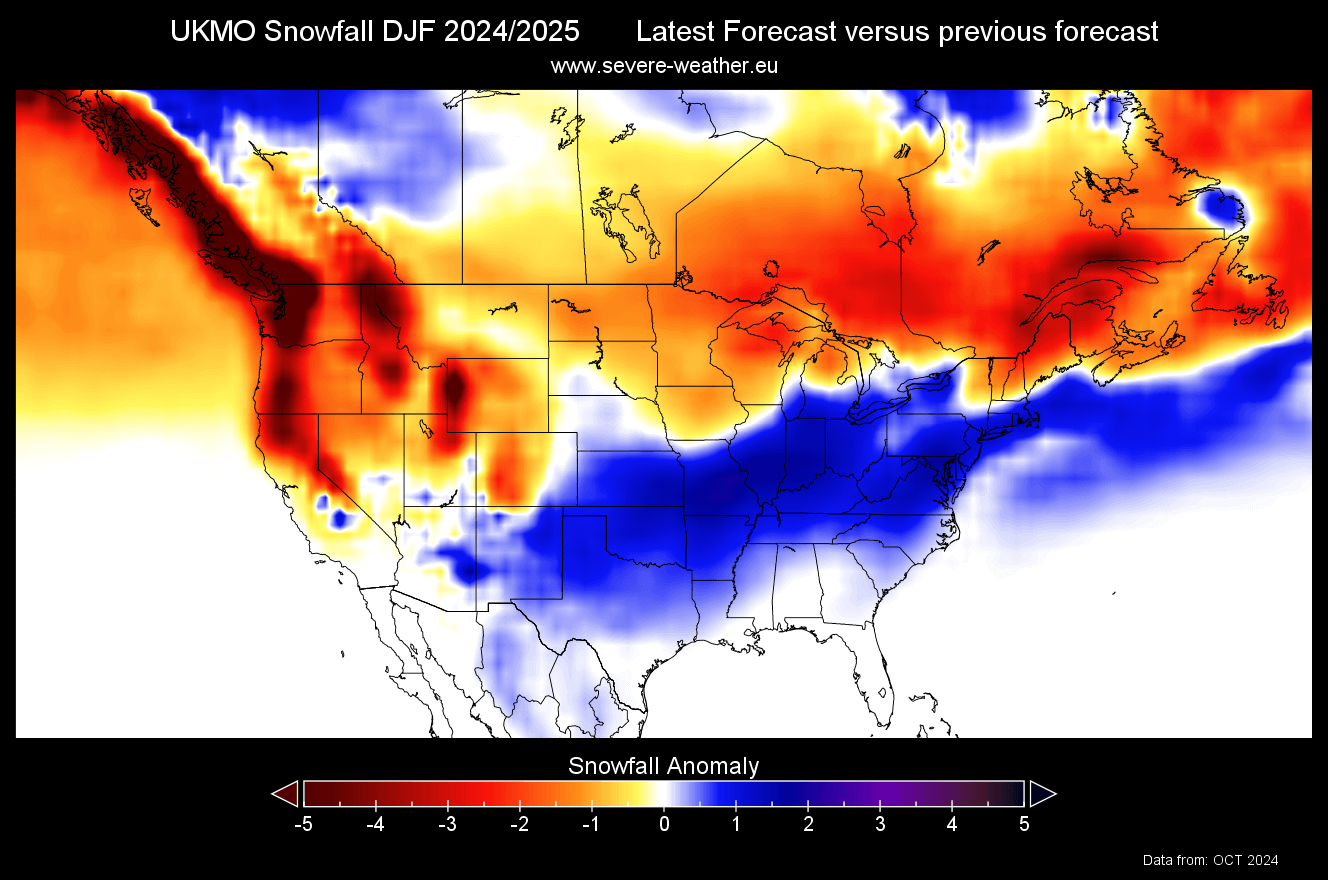
The December snowfall forecast shows more snowfall over much of Canada and parts of the far northern United States. Less snowfall is forecast over the rest of the United States and far southeastern Canada. This shows a rather slow snow season start, like in every other forecast.
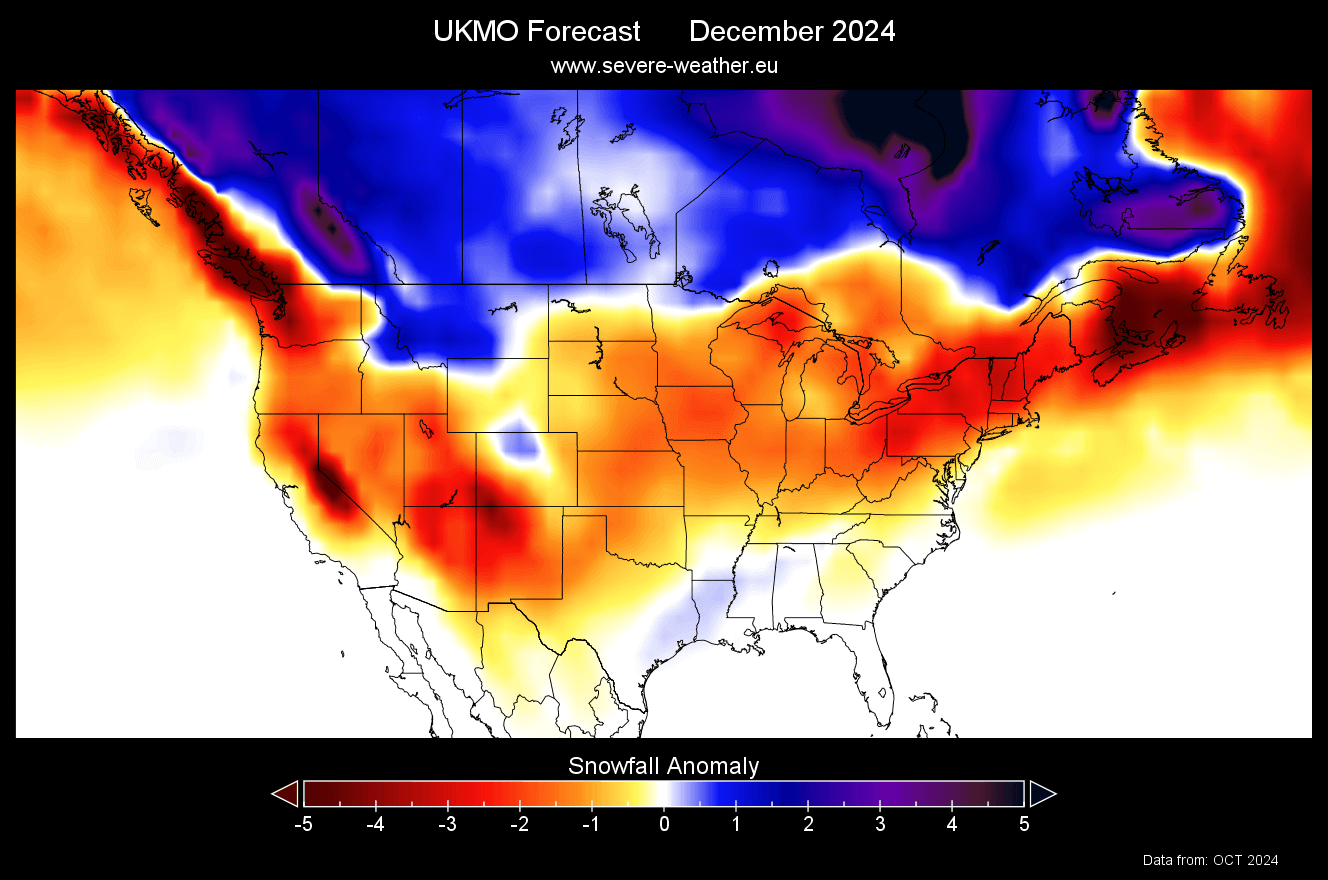
January snowfall forecast starts to increase the snowfall cover over the northern United States and the Midwest. The snowfall deficit is much lower over the northeastern United States, indicating a month-to-month snowfall increase since December.
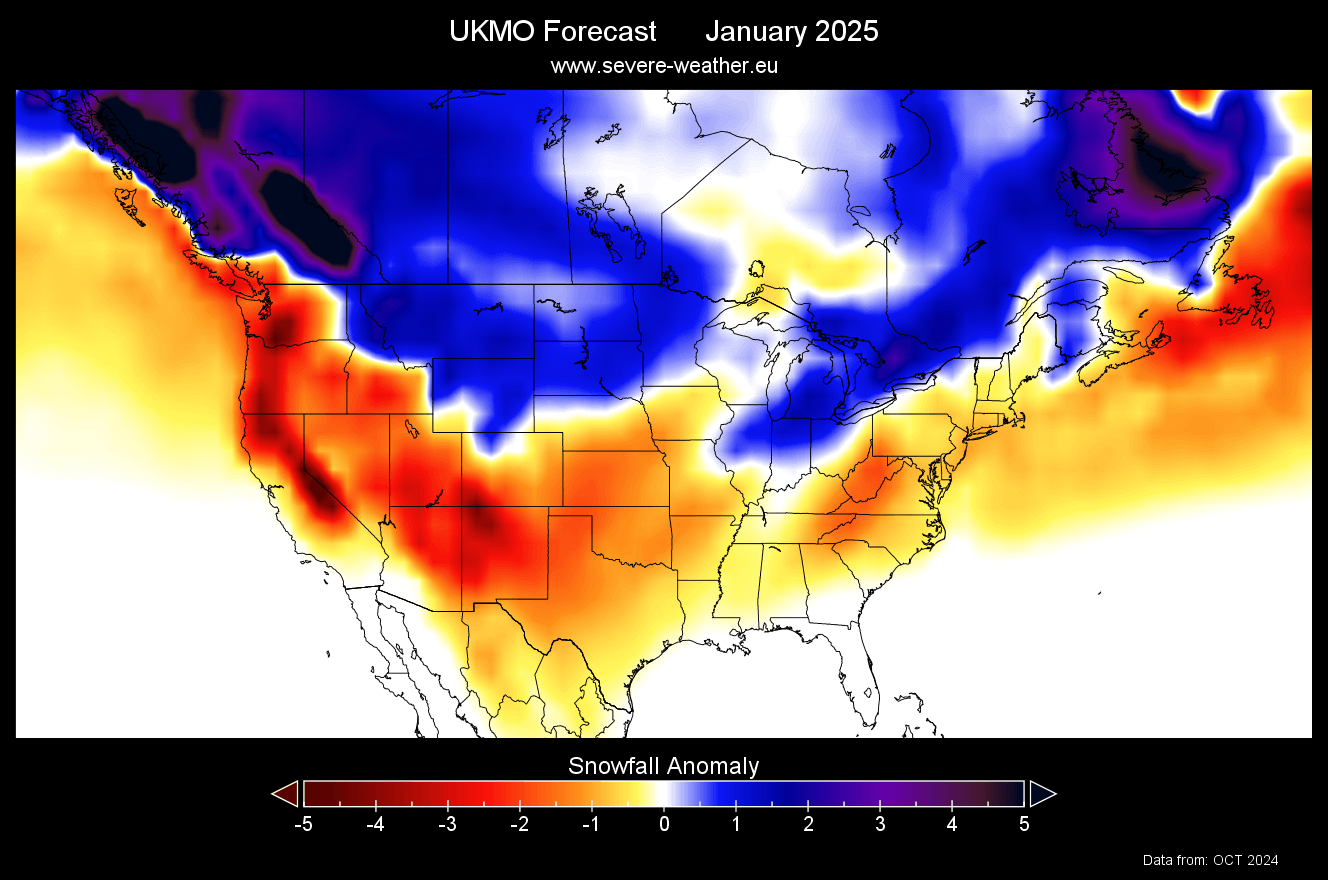
The February snowfall forecast shows a continuation of the snowfall area from January, covering much of the northern United States and upper Midwest and also increasing the snowfall potential over the northeastern United States.
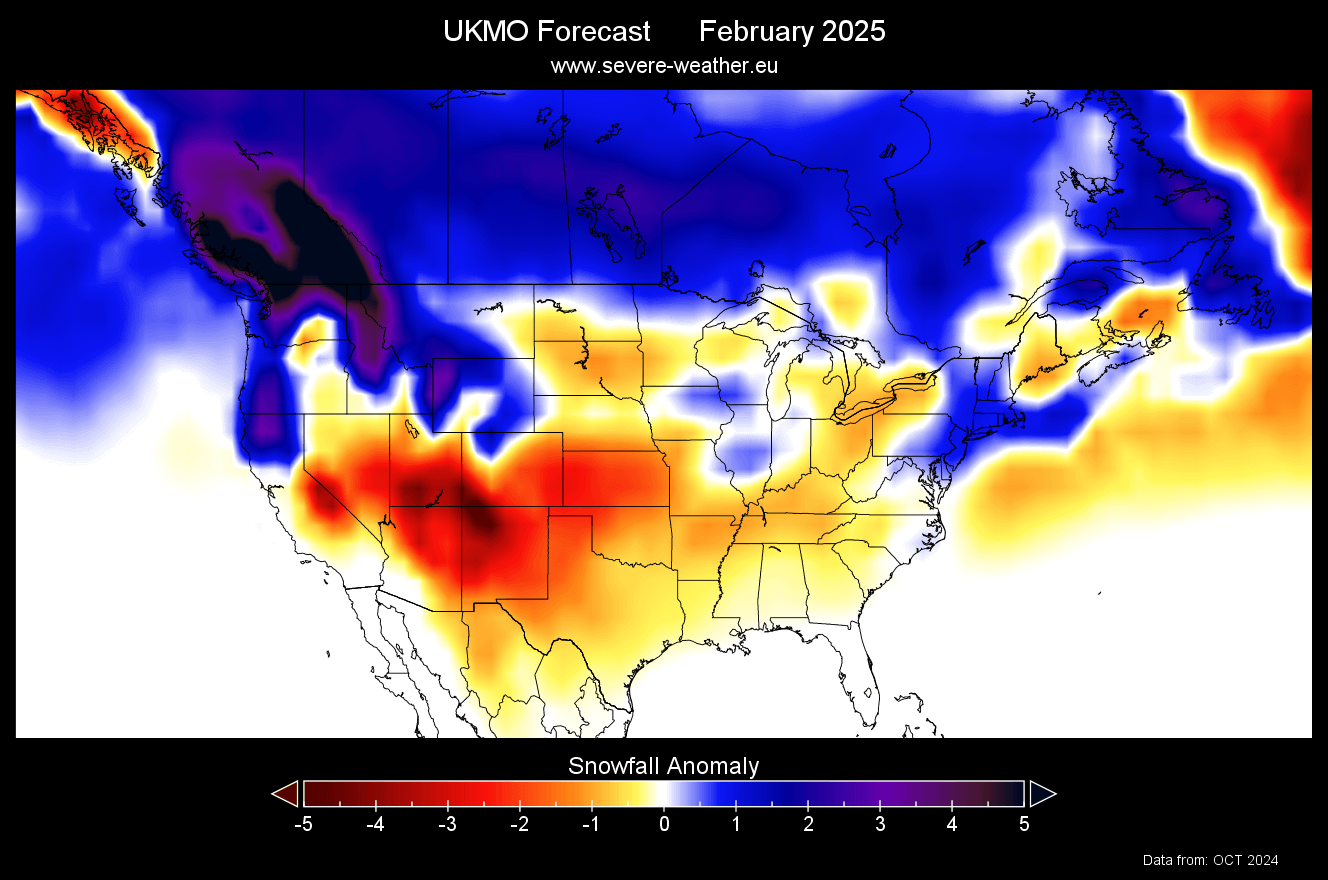
First March snowfall forecast shows good early Spring snowfall over much of southern Canada, the northern United States, and the upper Midwest. The southern half of the United States is forecast with less snowfall than normal for early Spring.
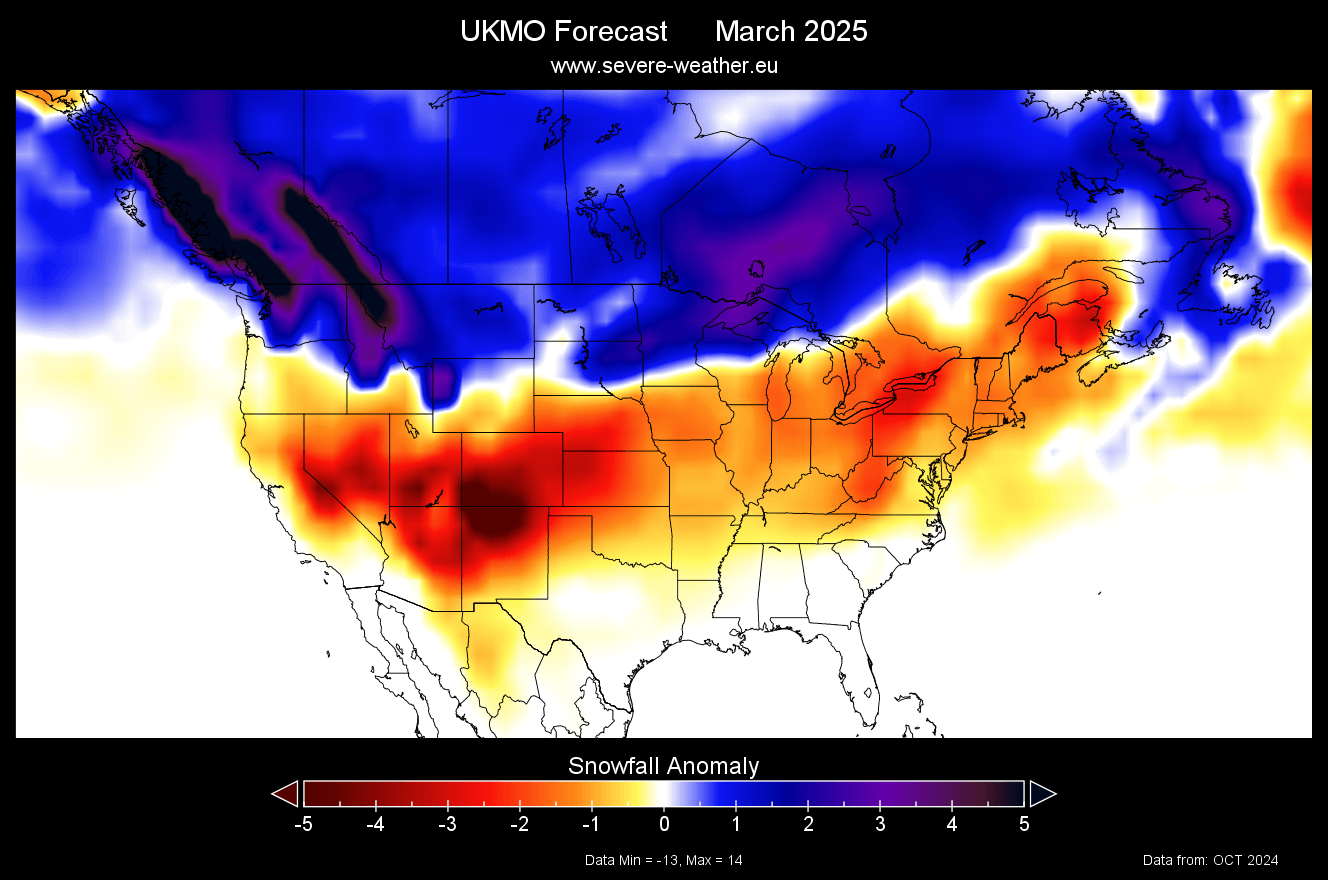
WINTER 2024/2025 OFFICIAL OUTLOOK
We can also find hints for the snowfall season in the official Winter 2024/2025 outlook by NOAA.
Below is the temperature forecast for the United States, issued in October. It shows the probability of winter temperatures, with colder chances in the northwestern United States and the upper Midwest. The southwestern part of the country and the east coast have a higher probability of warmer-than-normal winter.
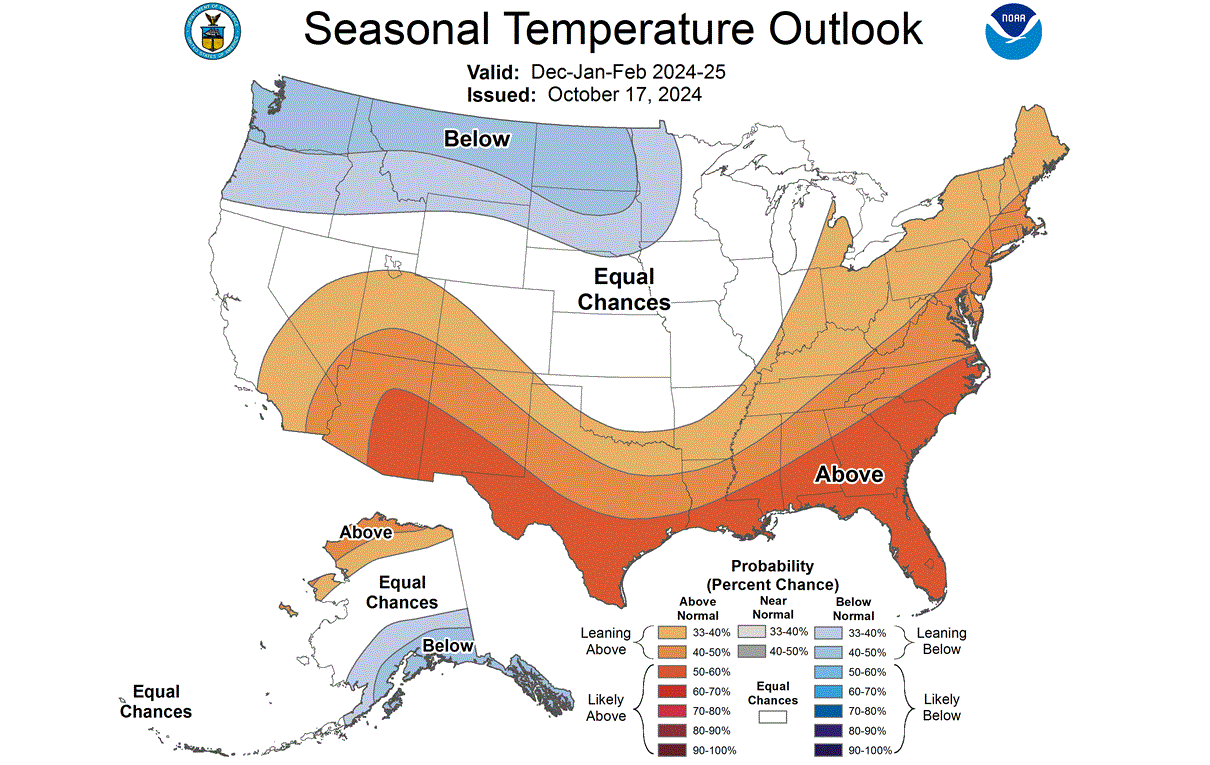
Like the snowfall forecasts above, this also shows colder air over the northern and northwestern United States. There is an area of “equal chance” expanding into the Midwest, which could also indicate the potential “highway” for some of the cold air movements into the eastern United States.
The official precipitation forecast also shows a typical La Niña pattern. You can see an equal-to-high probability of more precipitation over the northern half of the United States. Combined with a colder air trend, it puts the main snowfall potential over the northwestern United States, the upper Midwest, and parts of the Northeast.
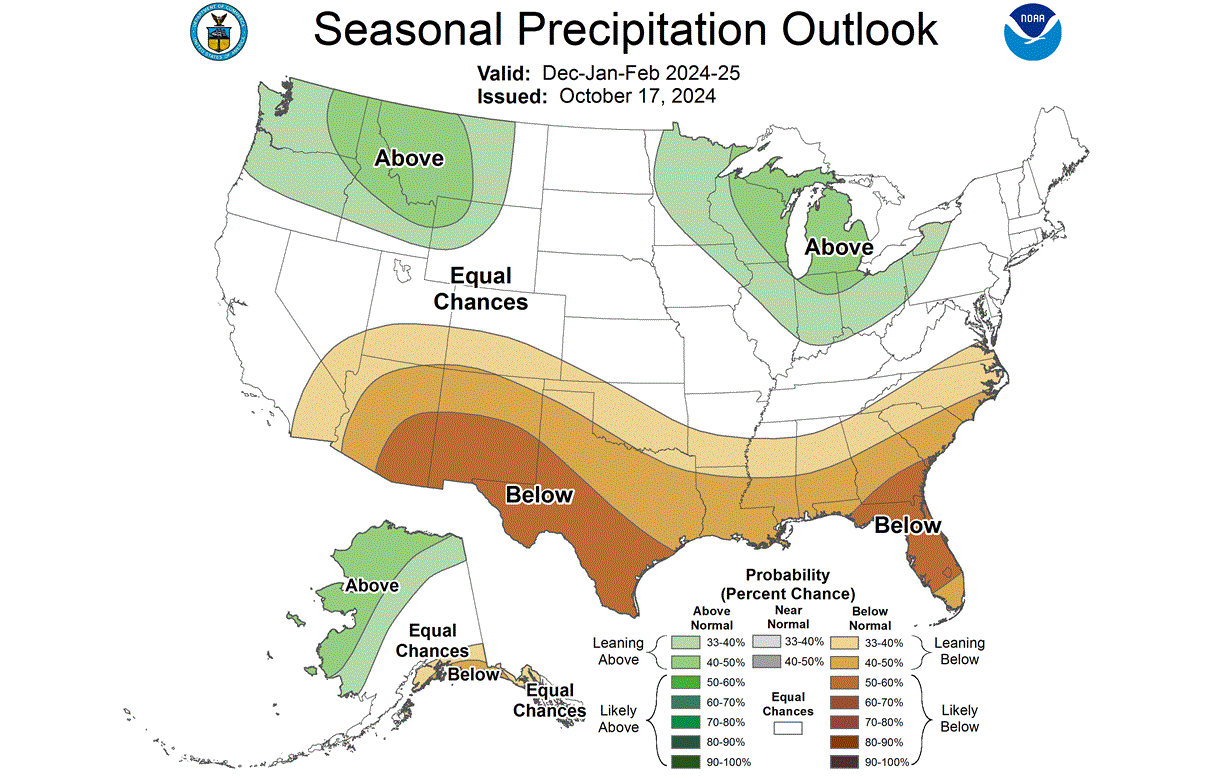
The southern United States is forecast to have a drier-than-normal winter season. In a typical La Niña winter, there is usually a development and persistence of drought conditions in the south and southwest of the United States.
We will keep you updated on other developing weather trends, so bookmark our page. Also, if you have seen this article in the Google App (Discover) feed, click the like button (♥) there to see more of our forecasts and our latest articles on weather and nature in general.
Don’t miss:
Winter 2024/2025: Latest pressure and temperature forecast for the United States, Canada and Europe